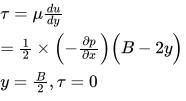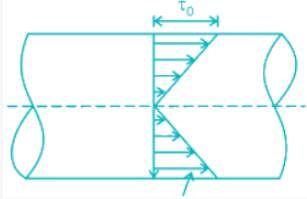SSC Exam > SSC Questions > If the velocity profile in laminar flow is p...
Start Learning for Free
If the velocity profile in laminar flow is parabolic, then the shear stress profile must be
- a)A hyperbola
- b)A parabola
- c)A straight line
- d)An ellipse
Correct answer is option 'C'. Can you explain this answer?
| FREE This question is part of | Download PDF Attempt this Test |
Verified Answer
If the velocity profile in laminar flow is parabolic, then the shear ...
Shear stress is proportional to the velocity gradient. So shear stress profile will be linear.
The velocity profile is parabolic:


Velocity Distribution curves for laminar and turbulent
Then the shear stress prole will be linear.


Shear stress distribution
Most Upvoted Answer
If the velocity profile in laminar flow is parabolic, then the shear ...
Shear stress is proportional to the velocity gradient. So shear stress profile will be linear.
The velocity profile is parabolic:


Velocity Distribution curves for laminar and turbulent
Then the shear stress prole will be linear.


Shear stress distribution
Free Test
FREE
| Start Free Test |
Community Answer
If the velocity profile in laminar flow is parabolic, then the shear ...
Shear stress in laminar flow
In laminar flow, a fluid moves in smooth, parallel layers with little to no mixing between them. The velocity of the fluid varies across the flow profile, with the highest velocity at the center of the flow and decreasing velocities towards the walls. This variation in velocity leads to a corresponding variation in shear stress.
Velocity profile in laminar flow
The velocity profile in laminar flow is typically parabolic. This means that the velocity of the fluid is highest at the center of the flow and decreases symmetrically towards the walls. The parabolic shape of the velocity profile is a result of the no-slip condition at the walls, where the fluid velocity is zero, and the fluid velocity at the center being the highest due to the absence of any wall effects.
Relationship between velocity and shear stress
The shear stress in a fluid is a measure of the force per unit area that is exerted on a fluid layer parallel to the direction of flow. It is directly proportional to the velocity gradient of the fluid. In other words, the shear stress increases as the velocity gradient increases.
Shear stress profile in laminar flow
Since the velocity profile in laminar flow is parabolic, the velocity gradient is highest at the walls, where the velocity is lowest. This means that the shear stress is highest at the walls and decreases towards the center of the flow. The shear stress profile in laminar flow is therefore a straight line, with the highest shear stress at the walls and zero shear stress at the center.
Conclusion
In summary, in laminar flow, the velocity profile is parabolic and the shear stress profile is a straight line. The parabolic velocity profile leads to a variation in velocity across the flow, which in turn leads to a variation in shear stress. The highest shear stress occurs at the walls and decreases towards the center of the flow.
In laminar flow, a fluid moves in smooth, parallel layers with little to no mixing between them. The velocity of the fluid varies across the flow profile, with the highest velocity at the center of the flow and decreasing velocities towards the walls. This variation in velocity leads to a corresponding variation in shear stress.
Velocity profile in laminar flow
The velocity profile in laminar flow is typically parabolic. This means that the velocity of the fluid is highest at the center of the flow and decreases symmetrically towards the walls. The parabolic shape of the velocity profile is a result of the no-slip condition at the walls, where the fluid velocity is zero, and the fluid velocity at the center being the highest due to the absence of any wall effects.
Relationship between velocity and shear stress
The shear stress in a fluid is a measure of the force per unit area that is exerted on a fluid layer parallel to the direction of flow. It is directly proportional to the velocity gradient of the fluid. In other words, the shear stress increases as the velocity gradient increases.
Shear stress profile in laminar flow
Since the velocity profile in laminar flow is parabolic, the velocity gradient is highest at the walls, where the velocity is lowest. This means that the shear stress is highest at the walls and decreases towards the center of the flow. The shear stress profile in laminar flow is therefore a straight line, with the highest shear stress at the walls and zero shear stress at the center.
Conclusion
In summary, in laminar flow, the velocity profile is parabolic and the shear stress profile is a straight line. The parabolic velocity profile leads to a variation in velocity across the flow, which in turn leads to a variation in shear stress. The highest shear stress occurs at the walls and decreases towards the center of the flow.

|
Explore Courses for SSC exam
|

|
Similar SSC Doubts
If the velocity profile in laminar flow is parabolic, then the shear stress profile must bea)A hyperbolab)A parabolac)A straight lined)An ellipseCorrect answer is option 'C'. Can you explain this answer?
Question Description
If the velocity profile in laminar flow is parabolic, then the shear stress profile must bea)A hyperbolab)A parabolac)A straight lined)An ellipseCorrect answer is option 'C'. Can you explain this answer? for SSC 2024 is part of SSC preparation. The Question and answers have been prepared according to the SSC exam syllabus. Information about If the velocity profile in laminar flow is parabolic, then the shear stress profile must bea)A hyperbolab)A parabolac)A straight lined)An ellipseCorrect answer is option 'C'. Can you explain this answer? covers all topics & solutions for SSC 2024 Exam. Find important definitions, questions, meanings, examples, exercises and tests below for If the velocity profile in laminar flow is parabolic, then the shear stress profile must bea)A hyperbolab)A parabolac)A straight lined)An ellipseCorrect answer is option 'C'. Can you explain this answer?.
If the velocity profile in laminar flow is parabolic, then the shear stress profile must bea)A hyperbolab)A parabolac)A straight lined)An ellipseCorrect answer is option 'C'. Can you explain this answer? for SSC 2024 is part of SSC preparation. The Question and answers have been prepared according to the SSC exam syllabus. Information about If the velocity profile in laminar flow is parabolic, then the shear stress profile must bea)A hyperbolab)A parabolac)A straight lined)An ellipseCorrect answer is option 'C'. Can you explain this answer? covers all topics & solutions for SSC 2024 Exam. Find important definitions, questions, meanings, examples, exercises and tests below for If the velocity profile in laminar flow is parabolic, then the shear stress profile must bea)A hyperbolab)A parabolac)A straight lined)An ellipseCorrect answer is option 'C'. Can you explain this answer?.
Solutions for If the velocity profile in laminar flow is parabolic, then the shear stress profile must bea)A hyperbolab)A parabolac)A straight lined)An ellipseCorrect answer is option 'C'. Can you explain this answer? in English & in Hindi are available as part of our courses for SSC.
Download more important topics, notes, lectures and mock test series for SSC Exam by signing up for free.
Here you can find the meaning of If the velocity profile in laminar flow is parabolic, then the shear stress profile must bea)A hyperbolab)A parabolac)A straight lined)An ellipseCorrect answer is option 'C'. Can you explain this answer? defined & explained in the simplest way possible. Besides giving the explanation of
If the velocity profile in laminar flow is parabolic, then the shear stress profile must bea)A hyperbolab)A parabolac)A straight lined)An ellipseCorrect answer is option 'C'. Can you explain this answer?, a detailed solution for If the velocity profile in laminar flow is parabolic, then the shear stress profile must bea)A hyperbolab)A parabolac)A straight lined)An ellipseCorrect answer is option 'C'. Can you explain this answer? has been provided alongside types of If the velocity profile in laminar flow is parabolic, then the shear stress profile must bea)A hyperbolab)A parabolac)A straight lined)An ellipseCorrect answer is option 'C'. Can you explain this answer? theory, EduRev gives you an
ample number of questions to practice If the velocity profile in laminar flow is parabolic, then the shear stress profile must bea)A hyperbolab)A parabolac)A straight lined)An ellipseCorrect answer is option 'C'. Can you explain this answer? tests, examples and also practice SSC tests.

|
Explore Courses for SSC exam
|

|
Signup for Free!
Signup to see your scores go up within 7 days! Learn & Practice with 1000+ FREE Notes, Videos & Tests.


















